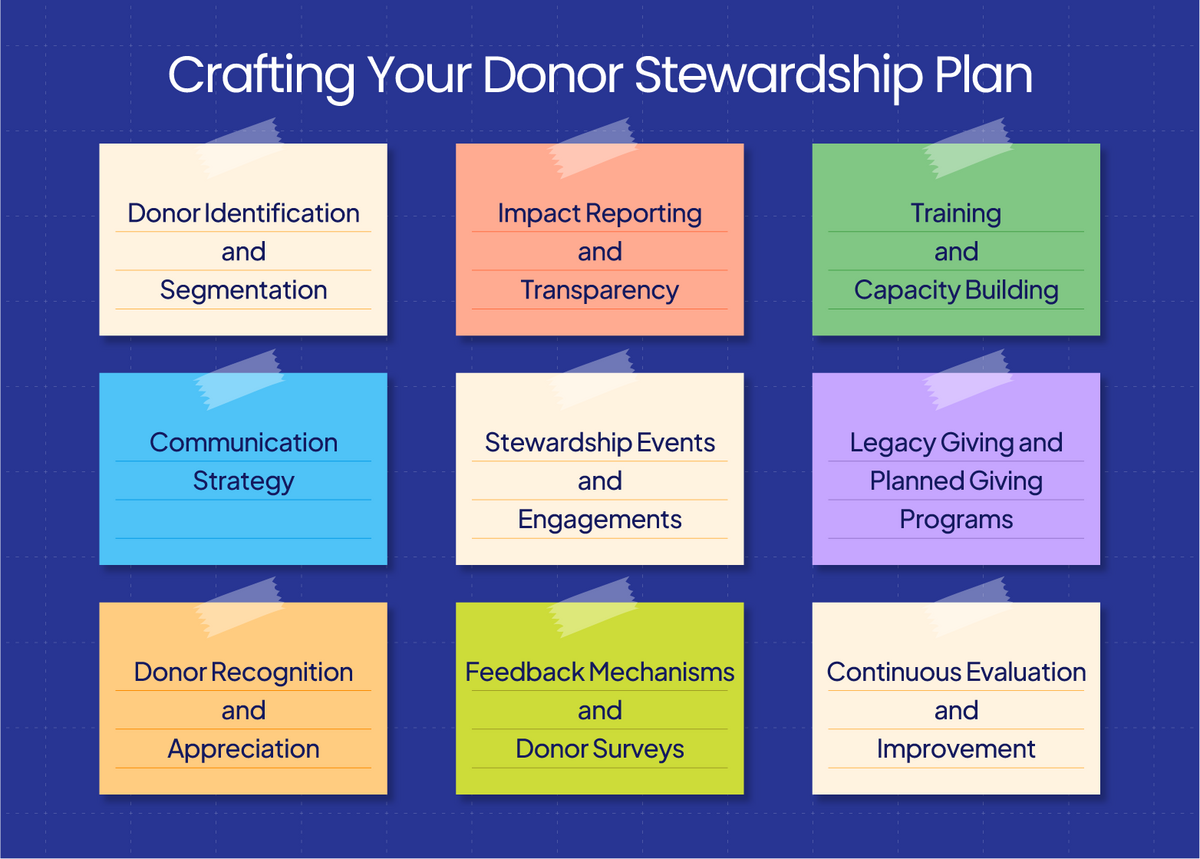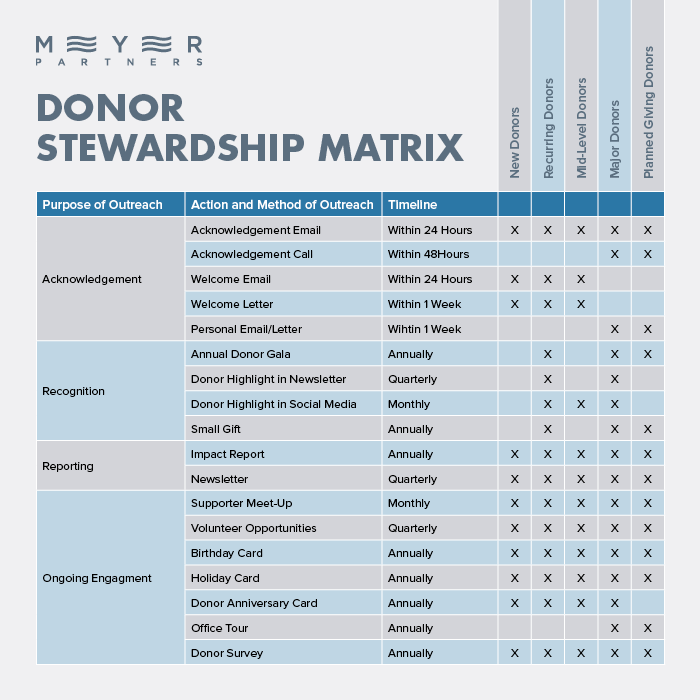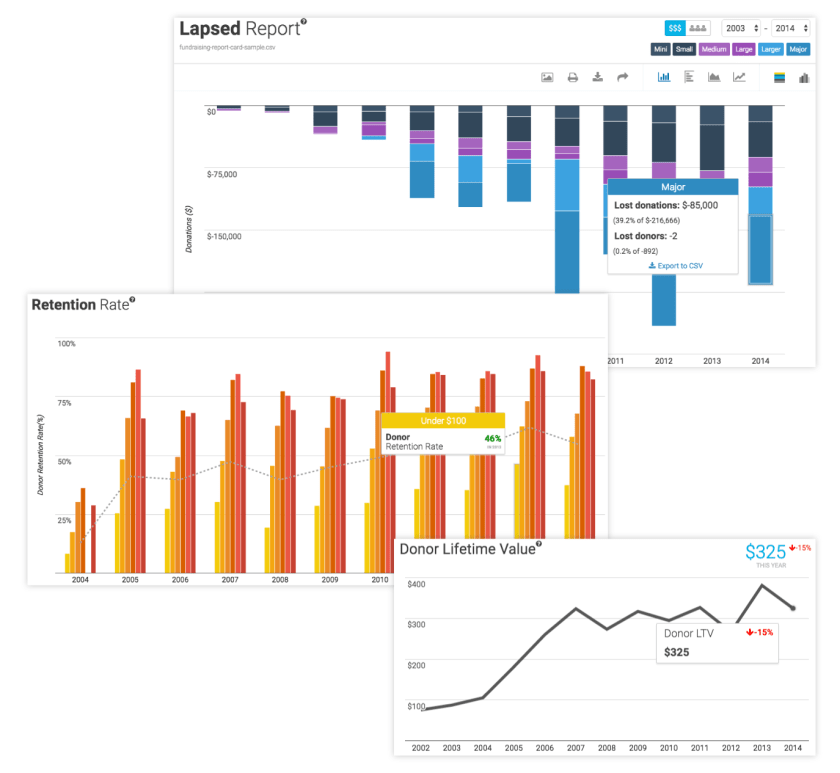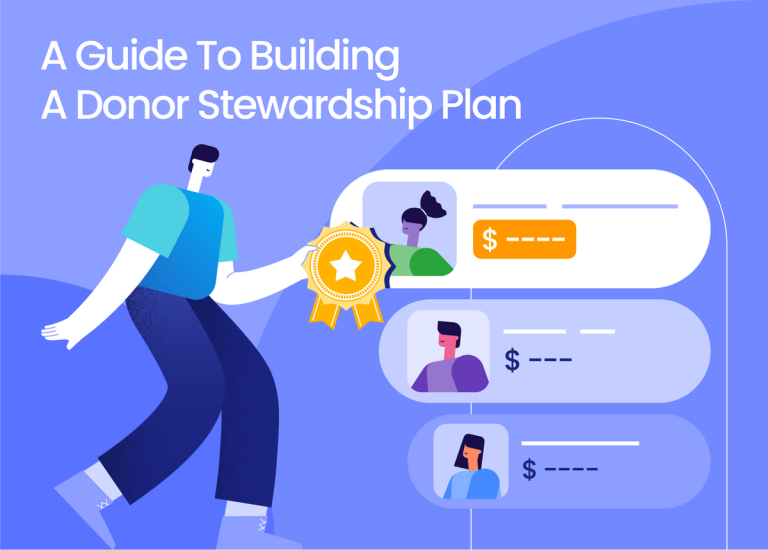Embarking on this journey, individuals will uncover methods to leverage tech for efficient donor oversight, craft nuanced messaging strategies for different levels of supporter involvement, and apply creative tactics to ensure each patron feels uniquely appreciated.
Delving into the nuances of tailoring your outreach, this blog is your handbook, offering hands-on advice for elevating retention and happiness levels among those who back you. Anticipate leaving this donor stewardship plan exploration with a refined grasp of how meticulously directed care fosters stronger connections and secures more consistent financial support for your group.
- Understanding the Basics of a Donor Stewardship Plan
- Segmenting Donors for Targeted Stewardship
- The Role of Communication in Donor Stewardship
- The Role of Technology in Enhancing Donor Stewardship
- Your Nonprofit’s Donor Stewardship Plan is Key to Success
Understanding the Basics of a Donor Stewardship Plan
At the heart of donor stewardship lies the art of cultivating relationships with those who support your cause. It’s about ensuring donors feel valued and informed about the impact of their contributions. A robust donor stewardship plan goes beyond simple thank-yous, offering a blueprint for creating lasting bonds with supporters.
So, why is this plan important?
Tailoring communication based on donor data, such as gift size or frequency, ensures messages resonate personally with each supporter.
Crafting Your Donor Stewardship Plan
To build solid foundations in donor stewardship, start by mapping out a comprehensive plan. This should detail:
- Donor Identification and Segmentation: How you will go about identifying potential donors and how you’ll segment donors into different categories based on their level of engagement, giving capacity, and preferences. A major tool to implement in this area is a donor pyramid.
- Communication Strategy: What your comprehensive communication strategy is and how you’ll use personalized messages, regular updates, and targeted appeals via communication channels, such as email, direct mail, social media, and phone calls, to effectively engage donors. You’ll want to use a donor matrix to identify different forms of communication for each type of donor.
- Donor Recognition and Appreciation: Establish protocols for recognizing donors at different giving levels, including personalized thank-you letters, acknowledgment in publications, and special events. Implement a systematic approach to expressing gratitude and appreciation for donors’ contributions.
- Impact Reporting and Transparency: How you will create impact reports that demonstrate the tangible outcomes and results achieved with donor support for ultimate transparency.
- Stewardship Events and Engagements: Plan and organize stewardship events such as donor appreciation dinners, exclusive tours, and behind-the-scenes experiences. The goal here is to provide opportunities for donors to interact with organizational leadership, program beneficiaries, and fellow supporters.
- Feedback Mechanisms and Donor Surveys: Establish mechanisms for soliciting feedback from donors about their experiences, preferences, and expectations. How you’ll conduct regular donor surveys to gather insights and identify areas for improvement in the stewardship process.
- Training and Capacity Building: Provide training and resources for staff, volunteers, and board members involved in donor stewardship. Equip team members with the skills and knowledge to cultivate and steward donor relationships effectively.
- Legacy Giving and Planned Giving Programs: Develop and promote legacy giving programs to encourage donors to include the organization in their estate plans. Support and guidance for donors interested in making planned gifts, including bequests, charitable trusts, and life insurance policies.
- Continuous Evaluation and Improvement: Regularly evaluate the effectiveness of the donor stewardship plan through key performance indicators (KPIs) such as donor retention rates, satisfaction surveys, and fundraising metrics.

By focusing on these areas and using data-driven insights to refine and improve stewardship strategies, organizations can create a robust donor stewardship plan that effectively engages donors, builds strong relationships, and sustains long-term support for their mission and programs.
The key is identifying every touchpoint along the cultivation cycle and creating standard operating procedures for ultimate efficacy.
Using Donor Pyramid & Stewardship Matrix
Before we move on to more information for your donor stewardship plan cultivation, we mentioned the donor pyramid and stewardship matrix above, and it’s important to clarify the role of these two incredible tools.
The donor pyramid provides a pyramid-shaped visual representation of the various levels of giving within an organization, ranging from small individual donations to major gifts and planned giving. This tool helps nonprofits identify potential donors, prioritize their efforts, and cultivate relationships effectively.
Complementing the donor pyramid, the stewardship matrix outlines specific strategies for engaging donors at each level, ensuring that they feel appreciated, valued, and connected to the organization’s mission.

By implementing these frameworks, nonprofits can tailor their approach to donor cultivation, retention, and recognition, ultimately fostering long-term support and sustainability.
Segmenting Donors for Targeted Stewardship
The foundation of these two tools is based on one thing – the segmentation of donor categories.
Every donor is unique, with their own reasons for supporting your cause. Recognizing this diversity through donor segmentation allows you to tailor your communication and stewardship efforts more effectively.
The power of personalized communication
Ensuring each contributor feels cherished necessitates categorizing them by factors such as the magnitude of their donation, their involvement intensity, and what captivates them.
By tailoring messages, we ensure they strike a chord with individuals, fostering a deeper connection. For example, penning bespoke appreciation messages or briefings that vividly illustrate the influence of their donation can greatly amplify donor contentment.
Cultivating mid-level donors and major donors
Concentrating on those who give at a mid-tier level frequently uncovers opportunities for expansion that had previously been overlooked. These supporters might increase their contributions when engaged correctly.
Similarly, major donors require a nuanced approach, given their significant financial support. Grasping what drives each faction’s kindness paves the way for crafting interactions that resonate deeply and personally with them.
This specialized attention not only fosters stronger relationships but also boosts retention rates—a win-win scenario echoed by statistics showing organizations employing effective segmentation strategies see up to a 50% increase in engagement rates.
The Role of Communication in Donor Stewardship
One of the top reasons to have a donor stewardship plan is to streamline your communication to help you retain donors. Whether it’s small donors, major donors, or mid-level donors, your communications need to go beyond a personal thank-you.
This process helps your organization build communication plans that truly create impact, build trust, and start showing appreciation to both your nonprofit’s current donors and new donors!
Here are a few things to consider doing to enhance donor communications
Daily: Social media
The power of social media in today’s digital age cannot be overstated when it comes to keeping your donors engaged.
Platforms like Facebook, Twitter, and Instagram let you share stories of how donations are making an impact. They also offer a space where donors can interact directly with your organization. The key here is consistency – regular posts keep your nonprofit top-of-mind for current donor groups while attracting potential new supporters.
Weekly: Email
Regular communication through weekly emails allows nonprofits to build and strengthen relationships with their donors over time.

Each weekly email presents an opportunity to include a clear call to action, whether it’s making a donation, volunteering, attending an event, or engaging with the organization on social media.
Monthly: Hosting exclusive events for donors
Exclusive events offer another avenue to strengthen bonds with your supporters. These gatherings are not just social occasions but opportunities for donors to see firsthand the impact their contributions make. Inviting supporters to immerse themselves in a setting where they can mingle with those directly impacted or observe real-time progress updates fosters enduring associations tied to their philanthropy.
The trick is tailoring these events carefully. Different types of donors might appreciate different kinds of engagement. While some may enjoy gala dinners or art auctions as ways to build community among philanthropists, others might find value in educational workshops that detail your nonprofit’s progress and future plans.
By weaving together innovative techniques like storytelling and exclusive events within your stewardship strategy, you cannot only maintain current supporter interest but also inspire increased giving over time.
Quarterly: Reporting
Quarterly reports demonstrate the organization’s commitment to accountability by providing donors with transparent and detailed information about how their contributions are being used. This helps to build trust and confidence in the organization’s stewardship of donor funds.

You can distribute these via email, individually via email customized for each donor, at events, or printed direct mail!
In essence, communication serves as the foundation of effective donor stewardship, facilitating meaningful engagement, fostering trust and loyalty, and ultimately sustaining long-term support for the organization’s mission and goals. By prioritizing transparent, personalized, and consistent communication efforts, nonprofits can cultivate strong relationships with donors and maximize their impact in advancing their mission.
The Role of Technology in Enhancing Donor Stewardship
Navigating the intricate maze of donor information presents a significant hurdle for charities, demanding adept maneuvering. This is where a donor database comes into play, acting as the backbone for any successful stewardship strategy.
Streamlining donor data management with CRM systems
A robust Customer Relationship Management (CRM) system not only organizes donor information but also automates communication and tracks engagement activities. It’s no wonder that organizations using CRM systems see an average increase in donor retention rates by 27%. For those looking to adopt or upgrade their current system, Micharity is a cost-effective CRM for nonprofits with robust solutions for organizations of all sizes.
Incorporating these technologies lets you create personalized stewardship plans tailored to different segments within your donor base. Recurring donors, significant benefactors, or newcomers to giving each necessitate distinct methods of dialogue and involvement.
Leveraging online giving software for enhanced engagement
The advent of digital technology has transformed the landscape of charitable contributions, streamlining both their collection and oversight. Online giving software, integrated into your website or social media platforms, provides donors with an easy and secure way to contribute financially.
The advantages reach further, offering a treasure trove of data on giving trends that can shape the roadmap for upcoming fundraising endeavors.
This technology empowers nonprofit teams to track the success of specific campaigns in real time, allowing for quick adjustments when needed. Furthermore, offering multiple payment options caters to a wider audience preference range, enhancing overall user experience and potentially increasing donation amounts.
The ease of donating is just one small factor of effective donor stewardship.
Making use of mobile giving options
Due to its convenience, mobile giving has become increasingly popular among donors as an online gift is typically much easier. By adopting mobile-friendly donation forms, QR codes at events, or text-to-donate services, nonprofits can meet donors where they spend most of their time—on their smartphones.
This approach not only broadens your reach but also taps into the impulse-giving trend, where individuals are more likely to make a small gift on the spot when moved by a story or specific call to action.
Moreover, it’s worth mentioning that the younger crowd leans towards handling dealings and engagements with entities through their mobile devices. Making it easier for them to donate in just a few taps can significantly boost engagement levels and your organization’s overall donation revenue.
Tailoring communication through advanced analytics
Donor stewardship efforts can become even more sophisticated with the slew of data collected through CRMs and online giving solutions. Advanced analytics let us understand our donors’ behaviors and preferences. This insight means we can craft more personalized outreach strategies that resonate with them personally.
Pairing your stewardship matrix with analytics is an incredible strategy for success.
Your Nonprofit’s Donor Stewardship Plan is Key to Success
You’ve now thoroughly immersed yourself in crafting strategies for stewarding donors, cultivating stewardship goals, and building relationship strategies that will lead to retaining donors. Now, it’s time to act.
Your donor stewardship strategy should start by embracing technology. Let it simplify how you manage and communicate with your supporters. If you want a full overview of utilizing a robust donor DRM for your donor stewardship plan, schedule a Stratly demo today.

